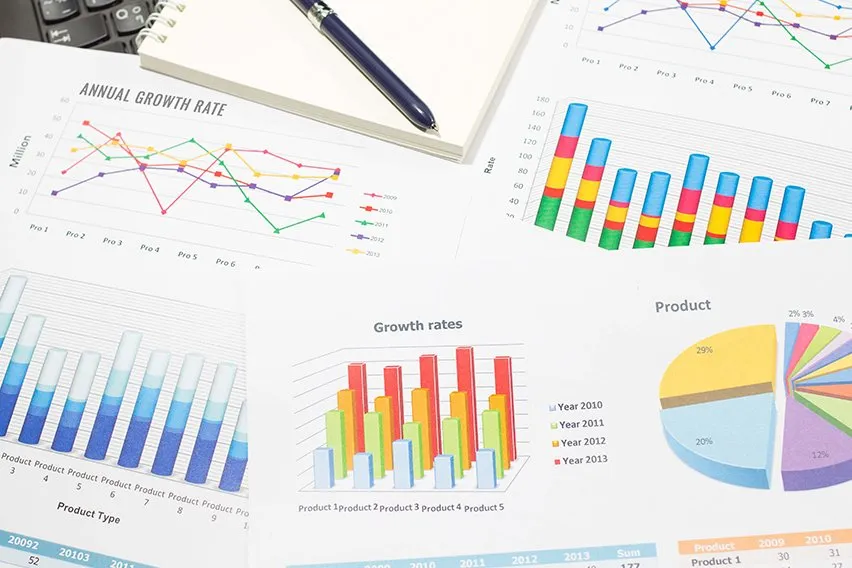What Is Aggregate Demand: Definition, Formula & Components

When you’re running your own business, it’s important to have a good grasp of your financial situation.
When gauging the economic health of a company, there are a number of different microeconomic and macroeconomic factors that can be looked at. Though one of the most important metrics that needs to be considered is the overall demand for the goods and services that are being produced.
That’s where aggregate demand comes into play.
But what exactly is aggregate demand? We’ll take a closer look at the definition, the formula used to calculate it, and the different components of aggregate demand.
Here’s What We’ll Cover:
What Is the Formula for Aggregate Demand?
What Are the Components of Aggregate Demand?
What Is the Aggregate Demand Curve?
How Do Price Levels Affect Aggregate Demand?
What Is Aggregate Demand?
Simply put, aggregate demand is the combined demand for all finished goods and services in an economy. It is shown as the total amount of money that has been exchanged for those goods and services over a certain time period.
It encompasses all of the spendings on:
- Consumer goods
- Capital goods
- Imports
- Exports
- Government spending programs

Aggregate demand is a macroeconomic term. Over the long term, it equals the gross domestic product, or GDP, as the two separate metrics are calculated in the same manner.
GDP represents the total amount of goods and services that are produced in an economy. Whereas aggregate demand is the demand or desire for those goods and services.
As both metrics are as a result of the same calculation methods, they both increase or decrease together at the same time.
What Is the Formula for Aggregate Demand?
When calculating aggregate demand, you add the amount of consumer, government and private investment spending, and the net of imports and exports.
It can be represented by the following formula:
Aggregate Demand=C+I+G+Nx
Where:
C = Consumer spending on goods and services
I = Business/Corporate spending and private investment on non-final goods
G = Government spending on social services and public goods
Nx = Net exports
What Are the Components of Aggregate Demand?
Aggregate demand is defined as the total demand for final goods and services in an economy. When looking at the law of demand, it works by assuming the other determinants of demand aren’t changing.
These determinants are:
- Income
- Prices of related goods or services
- Tastes
- Expectations
- The number of buyers in the economy
When looking at the components of aggregate demand, there are five main components. Although we’ve touched on them previously, the full list is as follows:
- Consumer Spending: This is what is spent on final products that aren’t used for investment.
- Investment Spending By Business: This is limited to purchases of equipment, buildings and inventory.
- Government Spending On Goods and Services: This does not include factors such as transfer payments. For example social security. These factors aren’t included because they don’t increase demand. Instead they shift demand from one group to another. In this case it’s the taxpayers to the beneficiaries.
- Exports: This would be the demand from different countries.
- Minus Imports: These are demands made by the local residents that cannot be met by production domestically. This means the demand leaves the economic system of the resident country.
What Is the Aggregate Demand Curve?
The aggregate demand curve, or AD curve, displays the total spending on domestic goods and services at all price levels. The AD for goods and services is put across the horizontal axis. While the overall price level of these goods and services is displayed on the vertical axis.
The AD curve indicates that a higher price level results in a decrease in total spending. It can shift as a result of different variations in the tax rates or in the money supply.
How Do Price Levels Affect Aggregate Demand?
There are a number of factors that come into play when discussing aggregate demand. As well as how and why price increases tend to lead to lower spending and a reduction of aggregate demand. Here are three of the main reasons why this may be the case:
Wealth Effect
When price levels increase, it comes with a decrease in the buying power of savings. As an increase in price reduces consumer wealth, consumption spending decreases accordingly.

Interest Rate Effect
An increase in price levels will boost demand for money, and therefore will boost credit. This in turn will force interest rates higher which will then diminish borrowing by businesses. This would be for the purpose of investment.
Due to this, the borrowing by households for higher value items such as houses or cars will diminish. This thereby reduces overall spending.
This can attempt to be countered by lowering interest rates.
Foreign Price Effect
When Australian prices rise while other countries remain the same, Australian goods will become more expensive for the rest of the world. This will then increase the price of Australian exports and therefore decrease their quantity.
On the flip side, this makes international imports cheaper and their quantity will increase.
Because of this, an increase in domestic price level compared to other countries results in a decline of net export expenditures.
Key Takeaways
Aggregate demand is an important and interesting metric to consider when looking at the economy.
AD can gauge the general strength of businesses and individual participants in the economy. However, it cannot account for other economic metrics. For example the standard of living.
This is the same for the formula used as it treats all factors as uniform and constant. This then results in inaccurate assumptions. This can then lead to difficulty in attempting to determine actual influential factors.
Are you looking for more business advice on everything from starting a new business to new business practices?
Then check out the FreshBooks Resource Hub.
RELATED ARTICLES

 What Is Consignment Stock or Inventory & How Does It Work?
What Is Consignment Stock or Inventory & How Does It Work? What Is Times Interest Earned Ratio & How to Calculate It?
What Is Times Interest Earned Ratio & How to Calculate It? Principal Amount: Definition, Formula & Calculation
Principal Amount: Definition, Formula & Calculation What Is the Order to Cash (O2C) Cycle? Definition & Benefits
What Is the Order to Cash (O2C) Cycle? Definition & Benefits Compound Annual Growth Rate (CAGR): Overview & Calculation
Compound Annual Growth Rate (CAGR): Overview & Calculation What Is the Discount Factor & How to Calculate It?
What Is the Discount Factor & How to Calculate It?